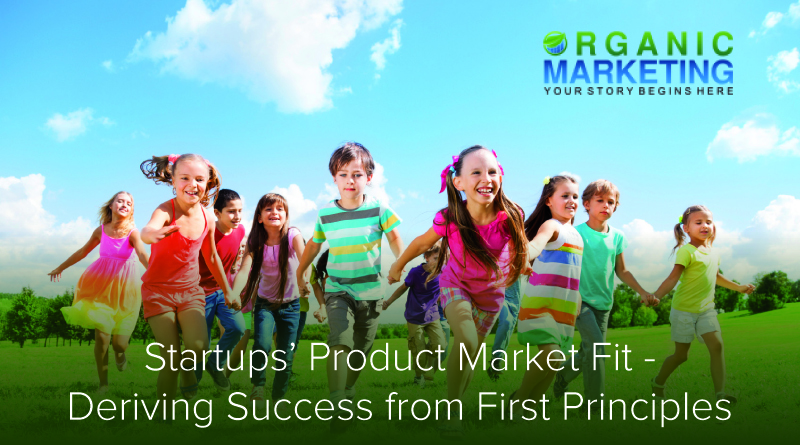Startup’s Product Market Fit – Deriving Success from First Principles
Understanding the Inflection Points in the Start Up Journey
A start up journey can be quite a roller coaster, especially, when it is still early stage trying to bring the needed traction. I am sure, you all have heard of the ‘product market’ fit concept. It is when startups need to vet their idea/product with different market segments and find that niche. This is the quintessential step in this multi-step journey.
What does finding the niche mean? In simple terms, it is when people want/need your product and would be disappointed if you went out of the market. Having seen the startup world for a little bit now, it seems like this is the crucial, make or break phase.
From looking at history, most startups have about 1-2 years of reaction time to make this fit happen. More than 66% of early stage startups do change their original idea to take off and scale, while others struggle. But if the ‘fit’ has not happened in that time, then it’s safe to say that there’s no merit in investing more in that idea. Nothing wrong with the idea, but it has found a demand or the market has already addressed that need.
And if you got out of this effort without burning cash in sales and marketing, you made some wise moves there.
Bringing in the Love Before Hitting the Growth Pedal, Why?
Startups, some times, hit the pedal when they receive the first burst of capital. They want to hire VP of Sales and Marketing, give a facelift to the company, invest in salesforce and marketing automation, talk to an analyst and press. This is also known as trying to make some noise.
Investors have believed in the idea, fair enough, but there is a step before hitting the pedal. That step is for the founders to roll up their sleeves and get into the trenches to create the MVP (minimum viable product) to bring the traction.
Once you have built that basic MVP framework, it is the time to run as many betas as possible, go into the field and see how customers are using this product. Sometimes, brilliant product initiatives and ideas emerge from here as you see your customers use the product. Be as receptive as you can to new ideas and thoughts in this phase. This is the flock that will get you the best grass!
Of course, you will be collecting all this feedback and changing the code as founders. But it is also the time to draw a delicate balance and not over evaluate the results. All data has to be normalized across the curve to figure the averages and skews, very carefully. In short, this is also the most exciting and fun time for the founders, but also the most testing one.
Stacking the Odds and Establishing Growth
Once you are over the hump with the testing period and come out successful, you can think of your key differentiators to go-to-market.
It would still be wise to refrain from pouring in the capital into sales and marketing. This is the time for ‘growth hacking’ and establishing the repeatability. Keep in mind that not all beta customers are going to convert, so this will be the ground to ring in more of those conversions.
Once the idea is validated and a growth trajectory established, it is a matter of bringing the volumes. And, here is the good news with marketing – now, there are a LOT of tools that can help you to validate your marketing assumptions very easily. Starting from SEO, SEM, CMS and extending it to Marketing Automation, you have a lot of stuff out there available on subscription. And, a lot of free channels and resources to take advantage of.
Scaling Cautiously with Pillars of Strength
Now, you’ve proved that you can keep your burn low. You have validated your idea with more than just a couple of customers. You have established a solid go-forward path without the need of hitting any restart buttons. So, it’s time to look for those VPs, who, for the lack of a better word, will take all this groundwork to the next level and scale your dream. But remember, founders still make the best marketing leaders!
Apart from all the big shots, there are two other things that you should invest in the post MVP stage. One, on the marketing side, is GOOD content, and you’ll need a good marketer to do this for you. Thought leadership with blogs/webinars and visual content with infographics/videos, to capture those couple of seconds from your target to make the magic happen! Make sure to get someone who gets it.
Two, on the customer experience/UX front, is a designer who lives and breathes your product and can build the right user flows to drive the engagement. This might end up being an expensive affair, but definitely, worth every dollar you spend!
Good luck out there. This is not an easy journey, but who said we set out to achieve easy goals!
Have Fun!
About Organic Marketing:
Organic Marketing helps new and emerging technology startups think about marketing organically. Organic because the story of your product or service needs to be simple, original and compelling. Right from the marketing strategy to marketing execution, we cover the entire gamut.
About Padmini Murthy:

Before founding Organic Marketing, Padmini ran growth-marketing initiatives for start-ups in cloud and container management, e-commerce and mobility. She has taken products to market with successful funding and exit strategies.
She is currently focused on growth-marketing initiatives, demand generation strategy + execution, and product-market fit. She has expertise in building all types of marketing content like case studies, videos, white papers, blogs, infographics et al.
She is extremely hands-on with most marketing technology stacks that are required for marketing automation, CRM, website development and design, project management and collaboration, SEO and performance management, content marketing, list building, social media, asset and resource management.
Connect with her and Organic Marketing:
Web: www.organicmarketing.space
Twitter: https://twitter.com/makemktgmatter
LinkedIn: https://www.linkedin.com/in/padminimurthy/
Email: [email protected]

